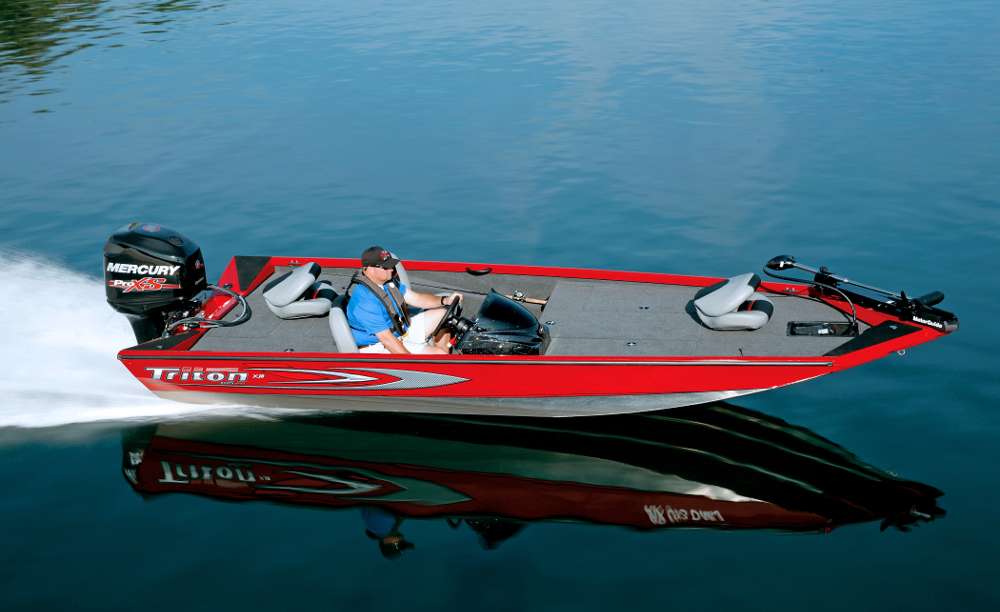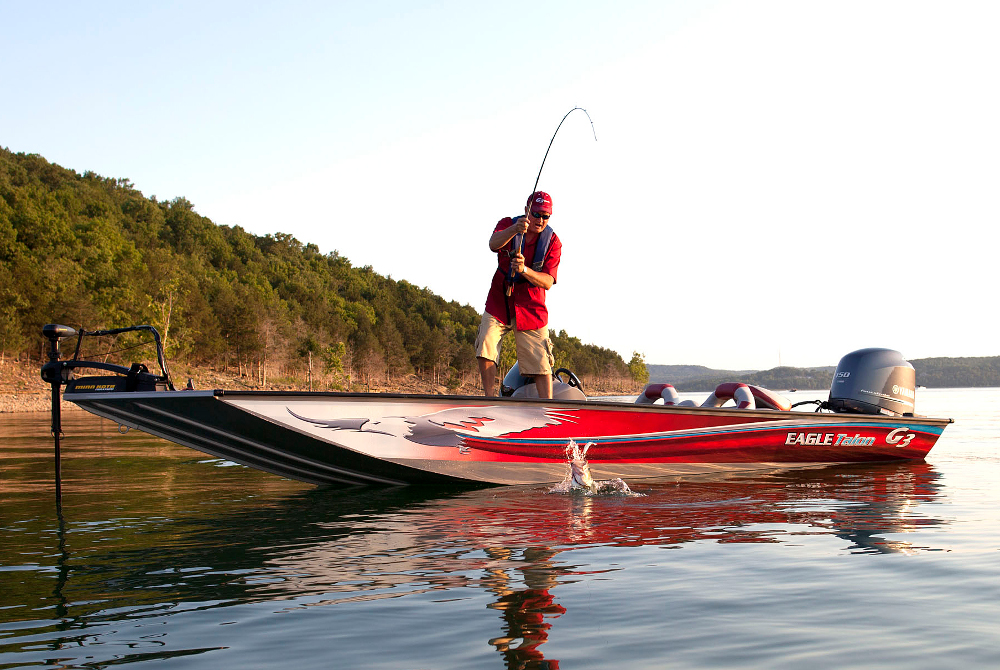
Most bass anglers are hard-working Americans who want and need their dollar to go as far as possible. We don’t have bundles of cash to spend on an Elite Series-level rig, though it’s nice to dream. So, we need a workhorse that does almost everything a 21-foot fiberglass boat can do without having to sell the farm. Enter the 21st-century aluminum boat.
Aluminum offerings today include 21-foot rockets in addition to the tried-and-true 16-foot flatbottom. Many anglers might prefer something in the middle, but skewing toward the high-end rig.
Multiple options in the 17- to 19-foot range will meet the needs of everyone who lacks deep pockets. G3 and Xpress Boats have long offered aluminum rigs that savvy anglers have enjoyed for their fishability and modest price. Just last year, Ranger and Triton debuted 17- and 18-foot boats to further expand the market: the Triton X17 and X18 and the Ranger RT178 and RT188. Though they come from the same plant in Flippin, Ark., the Triton and Ranger have different bloodlines.
The most popular go-to for anglers set on a tin rig has been Tracker, not only the No. 1 aluminum boat, but the No. 1 selling boat on the planet, and for good reason.
The boats feature an all-welded hull, whether you choose the 16-foot Pro 160 or the high-end Pro Team 190 TX, an 18-foot, 7-inch rig with an 89-inch beam, roughly 4 inches shy of full-size fiberglass boats.
Performance
Some of today’s popular aluminum rigs fall short of fiberglass counterparts in one department: speed. However, speed is the costliest (and arguably least necessary) aspect of a bass boat. You need a big hull and a big, gas-thirsty motor to top 70 mph. Ask yourself this: Do you need to go that fast? If you can check your ego at the door and settle for mid-50-mph performance, a sensibly priced aluminum is the rig for you.
But, if you’re still set on owning a full-size speedster, there are aluminum options for you there, too. Xpress Boats has been churning out 20-foot high-performance (70-plus-mph) aluminum rigs that handle like a fiberglass. They’re often just as heavy but are more durable for the simple reason that they’re aluminum. The Xpress X21 with a 250-horsepower Yamaha VMax SHO will hit 76.5 mph with two people and a full tank of gas. Though they have the performance, fishability and handling of a full-size fiberglass boat, they’re still more affordable. Xpress also offers more sensibly priced rigs in the 17- to 19-foot range that sip fuel from a 90- to 150-horse motor.
Like the Triton and Ranger aluminums, Xpress and G3 rigs are fully welded; there are no rivets anywhere, which are the weak points in any aluminum design.
The new Ranger and Triton have good performance in a package that retails for about $20,000. Add a 6-inch setback T-H Marine Z-Lock jackplate to a 115-horse Mercury OptiMax ProXS on Triton’s X18 and you’ll see 53-plus mph.
While the handling won’t rival that of a deep-V fiberglass boat, adding a prop with a nicely cupped blade will offer better grip around turns. The hull weight is just heavier than 1,100 pounds, which means you can dump these rigs into a farm pond and get them out again with a four-wheel-drive truck with as little as a few pebbles underfoot. A jackplate will also let you pick the outboard up to crawl over shallow sandbars and obstructions to get to hard-to-reach honey holes — places you’d likely not want to venture in a fiberglass boat.
Though the company is more well known for its deep-V multispecies boats, Lowe has a capable bass offering in its Stinger line. The ST195 is a 19-footer that can handle a 115-horse outboard as well as rough water thanks to its hull design. Dual 23-gallon livewells offer lots of space for limits of bass or stacks of perch.
Lund’s 1650 Rebel XL with a 50-horse Mercury will set you back less than $16,000. On the other end of the spectrum, the company’s 2075 Pro-V might be the burliest aluminum boat ever made. It’s a deep-V that can handle a 300-horse supercharged Mercury Verado, as well as nasty Great Lakes weather. Plus, there’s hardly an inch on the thing that isn’t some sort of storage. A 97-inch beam is wider than most fiberglass bass boats. Want to fill it up? It’s going to take 62 gallons of gas. But, with the big Merc, you’re looking at speed in the low 60s.
For a Tracker Pro Team 190 with a stainless prop and a 90-horse Mercury, you can expect 45 mph while sipping gas from a 21-gallon tank.
Options
 As with any boat, your base price will get you base-model accoutrement. As in many things, you get what you pay for. Affordably priced electronics are usually 5- or 6-inch-diameter numbers built in, but some manufacturers (including Triton and Ranger) offer 7-inch touch-screen HDS systems from Lowrance.
As with any boat, your base price will get you base-model accoutrement. As in many things, you get what you pay for. Affordably priced electronics are usually 5- or 6-inch-diameter numbers built in, but some manufacturers (including Triton and Ranger) offer 7-inch touch-screen HDS systems from Lowrance.
On a no-frills rig, you’re also looking at a 46-pound-thrust trolling motor. An 80-pound Minn Kota Fortrex is available, and advisable, on Rangers and Tritons. Other upgrades that are worth your attention are trailer brakes, Boat Buckle tie-downs, tailor-made covers and camouflage finishes for those of us who use the boat during duck season.
Xpress Boats’ X21 in the Xclusive Series comes with up to a 10-inch jackplate, Humminbird 998c Side Imaging depthfinders, an 80-pound Minn Kota Maxxum trolling motor, a stainless prop and more. Basically, you’re getting full-on fiberglass accessories in a 21-foot aluminum. If you go with the Team option, you’ll get dual Minn Kota Talons, a second console, a three-bank battery charger and discounts with several bait companies.
In short, owning an aluminum boat no longer means you’re a second-class citizen on the lake.
Longevity
Another benefit of aluminum is how rugged the things are. You don’t often see a decades-old fiberglass rig without major issues, but there’s no shortage of ancient aluminum boats that are still in good shape. Even if you bang it along a shallow riverbed or dump it down a dirt ramp, you won’t have your teeth gritted the whole time in anticipation of a puncture or tear. However, today’s rigs do require a bit of TLC from time to time. Many have automotive-grade paint and decals that need cleaning and maintenance. Regular washing and waxing will keep them sparkling for years. Want real-world durability? Lund offers a lifetime warranty on its products.
From tame tiller-steer flat bottoms to all-out Bassmaster Classic-ready bullets, the world of aluminums has changed for the better to the advantage of anglers — and their bank accounts.
Jack it up!
A jackplate has many uses, and those most often cited are the ability to raise the motor up to creep into shallow water, stabilize steering at high speeds and offer a better top end.
We added a 6-inch setback T-H Marine Z-lock manual plate to a Triton X18 with a 115-horse Mercury Optimax ProXS which was a handful to drive wide open at 51 mph. With the addition of the plate, the boat picked up more than 3 mph, got its holeshot back (it was a dog after the original 21-pitch prop was swapped for a 22), eliminated the “porpoising” effect when cruising and handled with aplomb at all speeds.
How can a plate do all of this? When you set the motor back, it runs in “cleaner” water because it’s farther from the hull of the boat. This helps with handling because there’s less air in the water that is rushing over the prop. Second, we picked the motor up 1 inch from the factory height on the transom, which again helps all-around performance. A plate doesn’t necessarily make your boat faster; it simply allows you to get everything out of it that it’s capable of doing. Short of repowering with a bigger motor, there’s not a more cost-effective way to enhance your boat’s performance.




